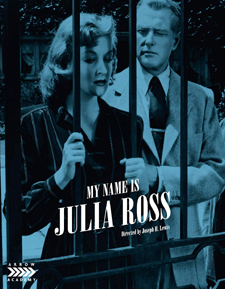My Name is Julia Ross (Blu-ray Review)

Director
Joseph H. LewisRelease Date(s)
1945 (February 19, 2019)Studio(s)
Columbia Pictures (Arrow Academy)- Film/Program Grade: B
- Video Grade: A-
- Audio Grade: B+
- Extras Grade: A
Review
[Editor's Note: This review contains spoilers.]
A low budget B movie that transcended its meager beginnings, My Name Is Julia Ross is a tightly-scripted film noir with elements of Rebecca and especially Gaslight, and an excellent ensemble cast. The title character (Nina Foch) is an American living in London. She has no family to rely on, has spent weeks fruitlessly looking for a job, and owes her landlady back rent. A new employment agency grants her an interview and she is grateful to be hired as a live-in secretary for Mrs. Hughes (Dame May Whitty).
Julia reports for work at an imposing house in London and is shown to her room. While she sleeps, her personal possessions are removed and burned. When she awakens, she finds herself in a mansion on a sea cliff in Cornwall and is told that she’s the delusional wife of Mrs. Hughes’ son, Ralph (George Macready). Realizing she must have been drugged, she finds herself trapped and her pleas for help fall on deaf ears. Her attempts to escape are blocked by a wall surrounding the house and a locked gate, guarded by a watchman.
The film is an example of the gothic thriller, with its foreboding mansion by the sea, secret passage, phony doctor, mysterious black cat, shadowy characters, barred windows, and a plot about a group of individuals trying to convince an innocent woman that she’s insane (we don’t learn their motive until late in the film). Director Joseph H. Lewis (Gun Crazy) creates a good deal of suspense as Julia repeatedly attempts to escape from her waking nightmare.
At 65 minutes, My Name Is Julia Ross doesn’t waste a single shot. Without padding or unnecessary dialogue, the movie zips along. Ms. Foch, who was under a seven-year contract at Columbia Pictures when she made the film, plays the damsel in distress with more self-reliance than the stereotype. Her Julia is frightened, but rather than fall apart and scream her head off, she tries to fathom the confusing situation and figure out how to get away.
Macready (Gilda), the consummate movie villain, is in top form here. Suave, yet subtly psychotic, his Ralph is seen methodically shredding Julia’s clothes with a knife and has to be talked down firmly by his mother lest their nefarious plot be exposed.
Based upon the book The Woman In Red by Anthony Gilbert, My Name Is Julia Ross is a good example of style over content. Director Lewis took 18 days to shoot the film instead of the budgeted 10, but studio head Harry Cohn was so impressed with his work – which incorporated many artful cinematic touches – that he fully backed the director. Its excellent cast, solid script, and moody camera work by Burnett Guffey elevate the film from the realm of the ordinary.
The Unrated high definition Blu-ray release features 1080p resolution. Aspect ratio is 1.37:1. The black-and-white photography is in a flat style, heavy on shadows. The variation in grays is well pronounced, with rich, dark blacks helping to convey atmosphere. Set design evokes old money, with assorted antiques throughout the house. The disc features an ucompressed English mono LPCM soundtrack. Though it doesn’t provide the surround feature that might enhance suspense, it effectively captures a driving rainstorm in the movie’s opening shot, waves crashing against the rocks below the house, a cat’s meowing, and whispered voices. English subtitles are available.
Bonus materials include feature-length commentary, the featurette Identity Crisis: Joseph H. Lewis at Columbia, the film’s trailer, and an insert booklet with an essay on the film by author and critic Adrian Martin.
Commentary – Noir expert Alan K. Rode provides brief career overviews of Nina Foch, George Macready, Dame May Whitty, director Joseph H. Lewis, and screenplay writer Muriel Roy Bolton, who was the primary writer on the 1950s TV show The Millionaire. Lewis found it challenging to work on films with limited budgets. Later in life, when his films were attracting renewed interest, Lewis often exaggerated his achievements. Foch recognized that the script for My Name Is Julia Ross was superior to others she had been given at Columbia. She went on to appear in An American In Paris, Executive Suite, and Spartacus. She longed to direct but was held back in Hollywood by her gender. She later went on to become an acting teacher and coach. One of her mantras: “You can’t play emotion. Emotion is the result of an action.”
Identity Crisis: Joseph H. Lewis at Columbia – Nora Fiore (The Nitrate Diva) provides an in-depth analysis of My Name Is Julia Ross, noting that it is about the anxiety of women, a theme prevalent in film after World War II. Lewis started as a camera loader and editor. He referred to himself as an “artist without a diploma.” The studio system allowed him to express his vision, as long as he stayed within budget. He shot title sequences for films, western features, and training films for the Signal Corps during World War II. My Name Is Julia Ross was previewed, a rarity for a B picture, primarily because of studio head Harry Cohn’s affection for it. Initially rowdy, the audience was soon won over by the movie’s “fairytale quality.” The film’s strong point is its nightmarish images, but the last scene looks staged and artificial – a nod to an audiences’ expectation of a happy ending. The movie “validates a woman’s thoughts and a woman’s sense of self.”
– Dennis Seuling

